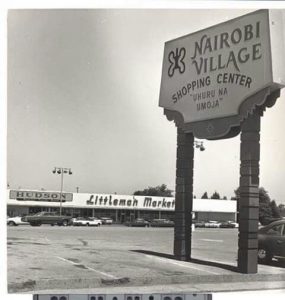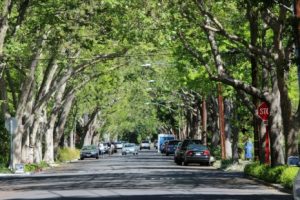The other side of the freeway
In the bottom drawer of my old black filing cabinet sits a battered cardboard box containing the manuscript of a novel I wrote in the early 1970s. I understand now why it never found a publisher. I was way too new to this country, and way too naïve, to do justice to its thorny subject: racial discrimination in housing. As I reread some of the text, I recalled the shock I felt when I first grasped the magnitude of the social gaps. The descriptions that follow come from my own experience as I researched the book, and it began my involvement with the fair housing movement.
Here is the central character Karen, a newspaper reporter, visiting the black ghetto of East Palo Alto for the first time to interview the director of a community advice center:
She knew vaguely that East Palo Alto belonged to the county. … She crossed the county line now, and accelerated to get onto the overpass that spanned the freeway. As she came down the ramp on the other side, she knew she was in a different country. The road was suddenly pot-holed and bumpy, and brown dust rose in thick choking swirls from its verges. She slowed, and looked about her. Such tiny bedraggled houses, desperately in need of paint. Yards littered with junk, yet here and there a brave attempt at order and color, a flower-bed, a well-cut lawn. She came upon a few tatty shops. Surely this couldn’t be the main shopping center? Yet soon she could see the sign, NAIROBI SHOPPING CENTER, and underneath, in a language she could not understand, UHURU NA UMOJA.
She had to force herself to open the door. Lurid accounts of rapes and muggings and violence in the streets flooded her mind. Here she was the enemy. She wanted to jump back into the car and get out, away from this place.
A woman passed, with two small children, headed for the market. She looked indifferently at Karen as she passed, then turned to scold one of the children, who was whining for candy. Karen let out the breath she had been involuntarily holding, and made herself move on. … Across the road, outside a liquor store, a black knot of middle-aged men stood transfixed in time, waiting for nothing.
It was hot. The dust lifted lazily as she walked. Something about the huge trees, and the stillness of the air, brought to her mind descriptions she had read of towns in the southern states. But this was California. It did not make sense. A mockingbird flashed its wings across her path, still proudly singing.
Karen does her interview, in which she learns about the pressures of living in East Palo Alto (and also finds herself attracted to Paul, the advice center director).
She said goodbye, and walked slowly back to the car, past the Louisiana Soul Food Kitchen and the Black and Tan Barber. The heat and dust were almost unbearable.
Back across the freeway, she noticed for the first time the neatly swinging redwood sign: Welcome to Palo Alto. A few blocks further down University Avenue and it hit her like a punch in the gut. She pulled over to the side of the road and rested her head on the steering wheel, fighting back an impulse to vomit. The contrast was an obscenity. Huge magnolias here lined the street on both sides, giving deep dappled shade to the well-paved highway. Between the road and the white concrete sidewalks rose great greening mounds of juniper and ivy, and beyond them, with manicured lawns and discreet sprinkler systems, were the complacent mansions of the rich.


Thank you for your comments, Rob. We don’t even see these contrasts, it seems, until we’re pushed into it. Lots of good wishes on your new job. I know you’ll find it satisfying to help kids along the path to a good job.
ps that photo of the shopping centre in East Palo Alto reminds me a bit of Otara shopping centre, a place where initially I was hesitant and wary to approach, but now its “my” shopping centre, im a bit middle class you see, and its taken me a little while to relax and see the friendliness and spirit of the place but how there is such a contrast in this city of ours
great writing Maureen,
Ive just changed careers from carpenter to lecturer in level 2 carpenter
teaching mostly young teens from sth auckland high schools. Im based at the Manukau Institute of Technology in Otara.
The difference in suburbs in Sth Auckland is sceemingly abrupt.
State houses, shopping malls, parks.
I grew up on the nth shore where there are pockets of state housing with mostly ngapuhi families to begin with in the late 50s but Sth Auckland is another story altogether. Poor every thing ,health, food, shops, schools,
The students I teach are mostly of polynesian background and they are a lively, great bunch of young people. Its a great job but im often comparing sth auckland to the rest of “affluent suburbs that im used to growing up in. The Pakeha teachers here that have grown up in Sth Auck are also from working class backgrounds and their health and education is of a lesser quality than that of the wealthier suburbs. A lot of Auckland would not have the inclination to be in Sth auck and these suburbs are judged accordingly. The surrounding where we teach are a run down old primary school, (Ilove it) next to a newer block and M.I.T marae. There are huge electricity pylons strewn across the suburbs of sth auck like sentries meeting big sub stations bring power from the hydro towns toAuckland. you kinda get the picture aye. Thanks for your writing Maureen arohanui Rob
“Karen” might have been less fearful and even more sympathetic had she had a chance to read “The Color of Law” before venturing into East Palo Alto. She might also have interviewed Wallace Stegner. His plans for a collaborative land development with a group of artists and scholars were scuttled by the government lenders who would only approve loans for all-white developments. Stegner’s group included an African American. The housing discrimination that was initiated and perpetrated by Federal, State and local governments is at the root of school and workplace segregation and is a factor in multi-generational economic inequality.